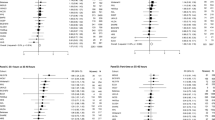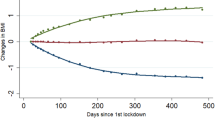Abstract
Objective:
The relationship between job strain and weight gain has been unclear, especially for women. Using data from over 52 000 working women, we compare the association between change in job strain and change in body mass index (BMI) across different levels of baseline BMI.
Subjects/Methods:
We used data from participants in the Nurses’ Health Study II (n=52 656, mean age=38.4 years), an ongoing prospective cohort study. Using linear regression, we modeled the change in BMI over 4 years as a function of the change in job strain, baseline BMI and the interaction between the two. Change in job strain was characterized in four categories combining baseline and follow-up levels as follows: consistently low strain (low at both points), decreased strain (high strain at baseline only), increased strain (high strain at follow-up only) and consistently high strain (high at both points). Age, race/ethnicity, pregnancy history, job types and health behaviors at baseline were controlled for in the model.
Results:
In adjusted models, women who reported high job strain at least once during the 4-year period had a greater increase in BMI (ΔBMI=0.06–0.12, P<0.05) compared with those who never reported high job strain. The association between the change in job strain exposure and the change in BMI depended on the baseline BMI level (P=0.015 for the interaction): the greater the baseline BMI, the greater the BMI gain associated with consistently high job strain. The BMI gain associated with increased or decreased job strain was uniform across the range of baseline BMI.
Conclusions:
Women with higher BMI may be more vulnerable to BMI gain when exposed to constant work stress. Future research focusing on mediating mechanisms between job strain and BMI change should explore the possibility of differential responses to job strain by initial BMI.
This is a preview of subscription content, access via your institution
Access options
Subscribe to this journal
Receive 12 print issues and online access
$259.00 per year
only $21.58 per issue
Buy this article
- Purchase on Springer Link
- Instant access to full article PDF
Prices may be subject to local taxes which are calculated during checkout


Similar content being viewed by others
References
Poirier P, Giles TD, Bray GA, Hong YL, Stern JS, Pi-Sunyer FX et al. Obesity and cardiovascular disease: pathophysiology, evaluation, and effect of weight loss—an update of the 1997 American Heart Association Scientific Statement on obesity and heart disease from the Obesity Committee of the Council on Nutrition, Physical Activity, and Metabolism. Circulation 2006; 113: 898–918.
Brunner EJ, Chandola T, Marmot MG . Prospective effect of job strain on general and central obesity in the Whitehall II Study. Am J Epidemiol 2007; 165: 828–837.
Eek F, Östergren P-O . Factors associated with BMI change over five years in a Swedish adult population: results from the Scania Public Health Study. Scand J Public Health 2009; 37: 532–544.
Kouvonen A, Kivimäki M, Cox SJ, Cox T, Vahtera J . Relationship between work stress and body mass index among 45810 female and male employees. Psychosom Med 2005; 67: 577–583.
Overgaard D, Gamborg M, Gyntelberg F, Heitmann BL . Psychological workload is associated with weight gain between 1993 and 1999: analyses based on the Danish Nurse Cohort Study. Int J Obes Relat Metab Disord 2004; 28: 1072–1081.
Nyberg ST, Heikkilä K, Fransson EI, Alfredsson L, DeBacquer D, Bjorner JB et al. Job strain in relation to body mass index: Pooled analysis of 160 000 adults from 13 cohort studies. J Intern Med 2011; 272: 65–73.
Wardle J, Chida Y, Gibson EL, Whitaker KL, Steptoe A . Stress and adiposity: a meta-analysis of longitudinal studies. Obesity 2011; 19: 771–778.
Hellerstedt WL, Jeffery RW . The association of job strain and health behaviors in men and women. Int J Epidemiol 1997; 26: 575–583.
Ishizaki M, Nakagawa H, Morikawa Y, Honda R, Yamada Y, Kawakami N et al. Influence of job strain on changes in body mass index and waist circumference: 6-year longitudinal study. Scand J Work Environ Health 2008; 34: 288–296.
Kivimäki M, Head J, Ferrie JE, Shipley MJ, Brunner E, Vahtera J et al. Work stress, weight gain and weight loss: evidence for bidirectional effects of job strain on body mass index in the Whitehall II study. Int J Obes (Lond) 2006; 30: 982–987.
Block JP, He Y, Zaslavsky AM, Ding L, Ayanian JZ . Psychosocial stress and change in weight among US adults. Am J Epidemiol 2009; 170: 181–192.
Rimm EB, Stampfer MJ, Colditz GA, Chute CG, Litin LG, Willett WC . Validity of self-reported waist and hip circumferences in men and women. Epidemiology 1990; 1: 466–473.
Karasek RA, Brisson C, Kawakami N, Houtman I, Bongers P, Amick B . The Job Content Questionnaire (JCQ): an instrument for internationally comparative assessments of psychosocial job characteristics. J Occup Health Psychol 1998; 3: 322–355.
Landsbergis PA, Schnall PL, Schwartz JE, Pickering TG, Warren K . The association of ambulatory blood pressure with alternative forms of job strain. Scand J Work Environ Health 1994; 20: 349–363.
Willett WC, Sampson L, Stampfer MJ, Rosner B, Bain C, Witschi J et al. Reproducibility and validity of a semiquantitative food frequency questionnaire. Am J Epidemiol 1985; 122: 51–65.
McCullough ML, Feskanich D, Stampfer MJ, Giovannucci EL, Rimm EB, Hu FB et al. Diet quality and major chronic disease risk in men and women: moving toward improved dietary guidance. Am J Clin Nutr 2002; 76: 1261–1271.
Mujahid MS, Diez Roux A, Shen M, Gowda D, Sanchez B, Shea S et al. Relation between neighborhood environment and obesity in the Multi-Ethnic Study of Atherosclerosis. Am J Epidemiol 2008; 167: 1349–1357.
Wolf A, Hunter DJ, Colditz GA, Manson JE, Stampfer MJ, Corsano K . Reproducibility and validity of a self-administered physical activity questionnaire. Int J Epidemiol 1994; 23: 991–999.
Ainsworth BE, Haskell WL, Leon AS, Jacobs DRJ, Montoye HJ, Sallis JF . Compendium of physical activities: classification of energy costs of human physical activities. Med Sci Sports Exerc 1993; 25: 71–80.
Pinto BM, Borrelli B, King TK, Bock BC, Clark MM, Roberts M et al. Weight control smoking among sedentary women. Addict Behav 1999; 24: 75–86.
McEwen BS . Protective and damaging effects of stress mediators. N Engl J Med 1998; 338: 171–179.
Pasquali R, Vicennati V, Gambineri A, Pagotto U . Sex-dependent role of glucocorticoids and androgens in the pathophysiology of human obesity. Int J Obes (Lond) 2008; 32: 1764–1779.
Champaneri S, Xu X, Carnethon MR, Bertoni AG, Seeman T, DeSantis AS et al. Diurnal salivary cortisol is associated with body mass index and waist circumference: the Multiethnic Study of Atherosclerosis. Obesity 2013; 21: E56–E63.
Purnell JQ, Kahn SE, Samuels MH, Brandon D, Loriauz DL, Brunzell JD . Enhanced cortisol production rates, free cortisol, and 11β-HSD-1 expression correlate with visceral fat and insulin resistance in men: effect of weight loss. Am J Physiol Endocrinol Metab 2009; 296: E351–E357.
Epel ES, McEwen BS, Seeman T, Matthews K, Castellazzo G, Brownell KD et al. Stress and body shape: stress-induced cortisol secretion is consistently greater among women with gentral fat. Psychosom Med 2000; 62: 623–632.
Kouvonen A, Kivimäki M, Väänänen A, Elovainio M, Ala-Mursula L, Virtanen M et al. Job strain and adverse health behaviors: the Finnish Public Sector Study. J Occup Environ Med 2007; 49: 68–74.
Lallukka T, Lahelma E, Rahkonen O, Roos E, Laaksonen E, Martikainen P et al. Associations of job strain and working overtime with adverse health behaviors and obesity: evidence from the Whitehall II Study, Helsinki Health Study, and the Japanese Civil Servants Study. Soc Sci Med 2008; 66: 1681–1698.
Choi B, Ko S, Landsbergis PA, Dobson M, Schnall PL . Job strain and health-related lifestyle. Am J Public Health 2014; 104: e3.
Smith P . Potentially misleading conclusions: Job strain and health behaviors. Am J Public Health 2014; 104: e4.
Heikkila K, Fransson EI, Nyberg ST, Zins M, Westerlund H, Westerholm P et al. Job strain and health-related lifestyle: findings from an individual-participant meta-analysis of 118 000 working adults. Am J Public Health 2013; 103: 2090–2097.
Lupien SJ, McEwen BS, Cunnar MR, Heim C . Effects of stress throughout the lifespan on the brain, behavior, and cognition. Nat Rev Neurosci 2009; 10: 434–445.
Zhao I, Bogossian F, Turner C . Does maintaining or changing shift types affect BMI? A longitudinal study. J Occup Environ Med 2012; 54: 525–531.
Leclere A . Shift-work and cardiovascular disease. Eur J Epidemiol 2010; 25: 286–286.
Hattori A, Sturm R . The obesity epidemic and changes in self-report biases in BMI. Obesity 2013; 21: 856–860.
Siegrist J . Adverse health effects of high-effort/low-reward conditions. J Occup Health Psychol 1996; 1: 27–41.
Acknowledgements
The collection of the Nurses’ Health Study II data were supported by the National Institutes of Health (UM1 CA176726). The analysis for this paper was supported by NIH grant P30 DK046200 and the National Institute for Occupational Safety and Health intramural grant (NORA-FY13-927ZKWG).
Disclaimer
The findings and conclusions in this paper are those of the authors and do not necessarily represent the views of the National Institute for Occupational Safety and Health.
Author information
Authors and Affiliations
Ethics declarations
Competing interests
The authors declare no conflict of interest.
Rights and permissions
About this article
Cite this article
Fujishiro, K., Lawson, C., Hibert, E. et al. Job strain and changes in the body mass index among working women: a prospective study. Int J Obes 39, 1395–1400 (2015). https://doi.org/10.1038/ijo.2015.91
Received:
Revised:
Accepted:
Published:
Issue Date:
DOI: https://doi.org/10.1038/ijo.2015.91
This article is cited by
-
Is work-family conflict a pathway between job strain components and binge eating? A cross-sectional analysis from the ELSA-Brasil study
Journal of Eating Disorders (2022)
-
Psychosocial Stressors at Work and Ambulatory Blood Pressure
Current Cardiology Reports (2018)
-
A socioecological framework for research on work and obesity in diverse urban transit operators based on gender, race, and ethnicity
Annals of Occupational and Environmental Medicine (2017)
-
Effort–reward imbalance at work and 5-year changes in blood pressure: the mediating effect of changes in body mass index among 1400 white-collar workers
International Archives of Occupational and Environmental Health (2016)



